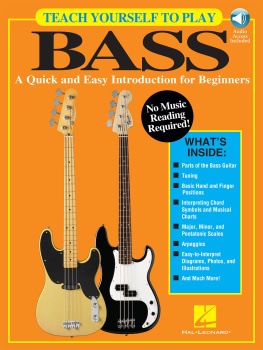
Bass Guitar For Dummies, 3rd Edition
Published by: John Wiley & Sons, Inc., 111 River Street, Hoboken, NJ 07030-5774, www.wiley.com
Copyright 2014 by John Wiley & Sons, Inc., Hoboken, New Jersey
Published simultaneously in Canada
No part of this publication may be reproduced, stored in a retrieval system or transmitted in any form or by any means, electronic, mechanical, photocopying, recording, scanning or otherwise, except as permitted under Sections 107 or 108 of the 1976 United States Copyright Act, without the prior written permission of the Publisher. Requests to the Publisher for permission should be addressed to the Permissions Department, John Wiley & Sons, Inc., 111 River Street, Hoboken, NJ 07030, (201) 748-6011, fax (201) 748-6008, or online at http://www.wiley.com/go/permissions .
Trademarks: Wiley, For Dummies, the Dummies Man logo, Dummies.com, Making Everything Easier, and related trade dress are trademarks or registered trademarks of John Wiley & Sons, Inc., and may not be used without written permission. All other trademarks are the property of their respective owners. John Wiley & Sons, Inc., is not associated with any product or vendor mentioned in this book.
LIMIT OF LIABILITY/DISCLAIMER OF WARRANTY : WHILE THE PUBLISHER AND AUTHOR HAVE USED THEIR BEST EFFORTS IN PREPARING THIS BOOK, THEY MAKE NO REPRESENTATIONS OR WARRANTIES WITH RESPECT TO THE ACCURACY OR COMPLETENESS OF THE CONTENTS OF THIS BOOK AND SPECIFICALLY DISCLAIM ANY IMPLIED WARRANTIES OF MERCHANTABILITY OR FITNESS FOR A PARTICULAR PURPOSE. NO WARRANTY MAY BE CREATED OR EXTENDED BY SALES REPRESENTATIVES OR WRITTEN SALES MATERIALS. THE ADVISE AND STRATEGIES CONTAINED HEREIN MAY NOT BE SUITABLE FOR YOUR SITUATION. YOU SHOULD CONSULT WITH A PROFESSIONAL WHERE APPROPRIATE. NEITHER THE PUBLISHER NOR THE AUTHOR SHALL BE LIABLE FOR DAMAGES ARISING HEREFROM.
For general information on our other products and services, please contact our Customer Care Department within the U.S. at 877-762-2974, outside the U.S. at 317-572-3993, or fax 317-572-4002. For technical support, please visit www.wiley.com/techsupport .
Wiley publishes in a variety of print and electronic formats and by print-on-demand. Some material included with standard print versions of this book may not be included in e-books or in print-on-demand. If this book refers to media such as a CD or DVD that is not included in the version you purchased, you may download this material at http://booksupport.wiley.com . For more information about Wiley products, visit www.wiley.com .
Library of Congress Control Number is available from the publisher.
ISBN 978-1-118-74880-0 (pbk); ISBN 978-1-118-74894-7 (ebk); ISBN 978-1-118-74897-8 (ebk); ISBN 978-1-118-74874-9 (ebk)
Manufactured in the United States of America
10 9 8 7 6 5 4 3 2 1
Chapter 1
The Very Basics of Bass
In This Chapter
 Differentiating between bass guitars and other guitars
Differentiating between bass guitars and other guitars
 Understanding the function and parts of the bass
Understanding the function and parts of the bass
 Getting ready to play bass
Getting ready to play bass
 Trying your hand at grooves, solos, fills, and different musical genres
Trying your hand at grooves, solos, fills, and different musical genres
 Picking up gear and taking care of your bass
Picking up gear and taking care of your bass
T he bass is the heart of music. Its unique qualities set up a gravitational field that draws you in perhaps it's the rich, deep, mellow sound or the hypnotic rhythms. In the right hands, the bass is a tremendously powerful tool, because it gives a band its feel and attitude. But what exactly is the bass? What makes the bass so powerful? And how does it contribute to giving music that irresistible feel? Whether you're a raw bass recruit or a seasoned veteran, this chapter helps you answer these questions.
Discovering the Differences between the Bass and Its High-Strung Cousins
Bass guitars differ from other guitars in several significant ways:
- Traditionally, basses have four strings, while guitars have six. In the 1970s, some bassists started adding strings. Nowadays, you can find five- and six-string basses (and beyond), but four-stringers are still considered the norm.
- Nearly all bass guitars are electric. Other guitars come in all flavors: electric, acoustic, or a combination of the two. You do encounter some beautiful acoustic bass guitars, but they're generally not loud enough to be of much use in a band (unless your band consists of just one or two acoustic guitar players who join you in your music-making endeavor).
- The bass strings are an equal distance musically from each other. The sound of each bass string is tuned an equal distance from the string above it, making the instrument perfectly symmetrical. So if you play a scale starting on one string, you can use the same fingering to play that same scale starting on a different string. This type of tuning makes playing the bass quite different from playing the guitar, where the second-highest string is tuned differently than the others.
- The bass has a lower pitch than the guitar. The deep notes of the bass fill the lower end of the sound spectrum. Think of these notes as the bass-ment, or foundation, of music.
- The bass's neck is longer than the guitar's, thus making its strings longer. The longer the string, the lower the pitch; the shorter the string, the higher the pitch. Think of a Chihuahua and a Saint Bernard, for example. The Chihuahua has short vocal chords, and a rather high-pitched bark; the Saint Bernard... well... you get the idea.
- The bass player and the guitarist serve different functions. I won't bore you with the guitarist's job description, but the bass player's makes for fascinating reading, as the next section shows. By the way, if you do happen to want to know more about the guitarist's job description, you can check out Guitar For Dummies, by Mark Phillips and Jon Chappell (Wiley).
Understanding the Bass Player's Function in a Band
As the bassist, you play the most crucial role in a band (at least in my opinion). Everyone in the group follows your subtle (and sometimes not-so-subtle) lead. If the guitarist or saxophonist makes a mistake, hardly anyone notices, but if the bassist makes a mistake, everyone in the band and the audience instantly knows that something is wrong (in which case you may want to throw an accusatory glance at one of your bandmates).
Forging the link between harmony and rhythm
You're responsible for linking the harmony (chords) of a song with a distinctive rhythm (groove). This link contributes to the feel (mood) and genre (general style) of the music, which together determine whether a song is rock, jazz, Latin, or anything else. Chapter tells you exactly what you need to do to establish excellent grooves, and Part IV discusses the different musical genres you're likely to play. The goal is to be able to emulate any bassist's style in any genre and, at the same time, to be creative using your own rhythms, notes, and ideas!
Moving the song along
Every song is made up of chords (harmony) that are particular to that song, and all the notes in the song relate to the sounds of those chords (see Chapter for more about chords). Some songs are based on only one chord, from beginning to end, and so all the notes relate to that one chord sound, making such songs easy to play. The chords of most songs, however, change as the song progresses. In these cases, the first group of notes in the tune relates to the first chord and has one kind of sound, the next group of notes relates to the next chord sound, and so on throughout the song.
Next page


















 Differentiating between bass guitars and other guitars
Differentiating between bass guitars and other guitars